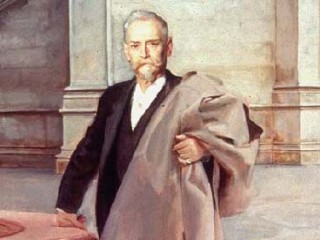
Richard Morris Hunt biography
Date of birth : 1827-10-31
Date of death : 1895-07-31
Birthplace : Brattleboro, Vermont,U.S.
Nationality : American
Category : Arhitecture and Engineering
Last modified : 2012-01-23
Credited as : architect, was American architecture's first statesman, founded both the American Institute of Architects and the Municipal Art Society
5 votes so far
Aside from Hunt's sculpting of the face of New York City, including designs for the facade and Great Hall of the Metropolitan Museum of Art, the pedestal of the Statue of Liberty and many Fifth Avenue mansions lost to the wrecking ball, Hunt founded both the American Institute of Architects and the Municipal Art Society.
Hunt's mentor Lefuel later permitted him to supervise work on the Louvre museum, which Lefuel and Louis Visconti were renovating for Napoleon III, as well as to design the Pavillon de la Bibliothèque (“Library Pavilion”), prominently situated opposite the Palais-Royal. Hunt would later regale aspiring young architect Louis Sullivan with stories of his work on the New Louvre in Lefuel's atelier libre.
After his return in 1855, Hunt founded the first American architectural school at his Tenth Street Studio Building (beginning with only four students), co-founded the American Institute of Architects and from 1888 to 1891 served as the Institute's third president, brought the first apartment building to Manhattan in a burst of scandal, and set a new ostentatious style of grand houses for the social elite and the eccentric, competitive new millionaires of the Gilded Age.
Hunt's greatest influence was his insistence that architects be treated, and paid, as legitimate and respected professionals equivalent to doctors and lawyers. He sued one of his early clients for non-payment of his five percent fee, which established an important legal precedent. One of his 1859 students at the Tenth Street Studio, William Robert Ware, was deeply influenced by Hunt and went on to found the first two university programs in architecture: MIT in 1866, and Columbia in 1881.
His extensive social connections in Newport among the richest Americans of his generation, were informed by his energy and good humor. Legend has it that while on a final walk-through of one of his Vanderbilt mansions, Hunt discovered a mysterious tent-like object in one of the ballrooms. Investigating, he found it was canvas covering a life-sized statue of himself, dressed in stonecutters' clothes, all carved in secret as a tribute by the gang of stonecutters working on the house. Vanderbilt permitted the statue to be placed on the roof of the mansion.
Most who came into contact with Hunt came away struck by the man. On their first meeting in 1869 Ralph Waldo Emerson spoke of "one remarkable person new to me, Richard Hunt the architect. His conversation was spirited beyond any I remember, loaded with matter, and expressed with the vigour and fury of a member of the Harvard boat or ball club relating to the adventures of one of their matches; inspired, meantime, throughout, with fine theories of the possibilities of art."
Hunt's folksy manner, lack of pretense and unbridled enthusiasm led Emerson to gush, "I could only think of the immense advantage which a thinking soul possesses when horsed on a robust and vivacious temperament. The combination is so rare of an Irish labourer's nerve and elasticity with Winckelmann's experience and cultivation as to fill one with immense hope of great results when he meets it in the New York of to-day."
Hunt designed New York's Tribune Building, one of the earliest with an elevator, in 1873. Other buildings of note that Hunt designed include the Theological Library and Marquand Chapel in Princeton, the Scroll and Key building at Yale, and the Fogg Museum of Art at Harvard. Until the Lenox Library, none of Hunt's American works were in the Beaux-Arts style with which he is associated. Late in his life he became involved in the Chicago's World's Columbian Exposition in 1893, at which his Administration Building received the gold medal from the Royal Institute of British Architects.
In New York City, Hunt's handiwork can be seen on the austere pedestal of the Statue of Liberty and on the elegant 5th Avenue facade of the Metropolitan Museum of Art. The only one of Hunt's New York City buildings that has not been destroyed now houses Hostelling International – New York (formerly American Youth Hostels) on the east blockfront of Amsterdam Avenue between 103rd and 104th Streets in Manhattan.The last surviving New York City building entirely by Hunt is the charity hospital he designed for the Association for the Relief of Respectable Aged Indigent Females (1883) on the east blockfront of Amsterdam Avenue between 103rd and 104th Streets in Manhattan. The red-brick building, which features dormer windows and a mansard roof similar to those Hunt used on his Biltmore Estate in Asheville, North Carolina, was renovated in the late 20th century and is now a youth hostel.
Among the many projects Richard Howland Hunt finished was the great entrance hall of the Metropolitan Museum of Art, for which his father, a Metropolitan trustee, had made the initial sketches in 1894, having earlier designed the Museum's Fifth Avenue facade.
















